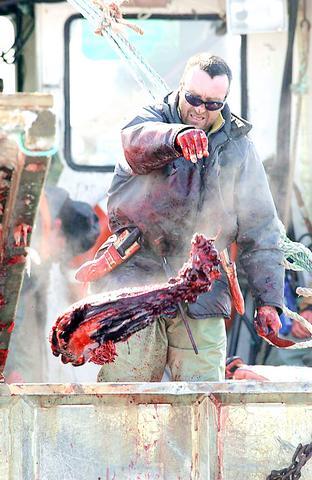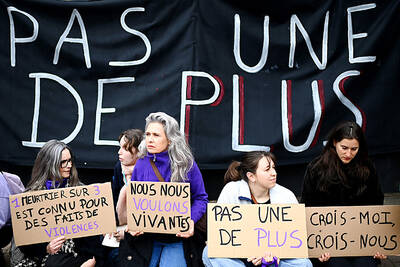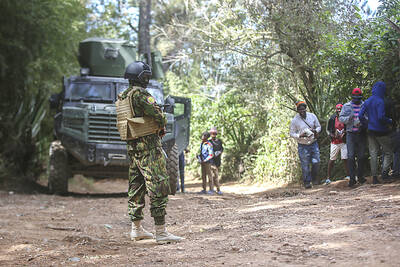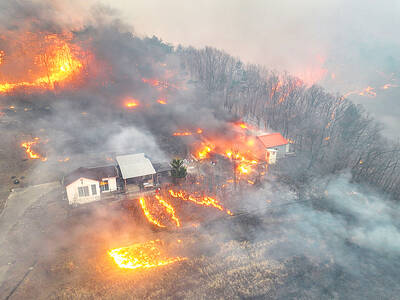Some 12,000 sealers armed with rifles and spears launched for the ice floes and islands off eastern Canada on Monday in the world's largest seal hunt, accompanied by protesters condemning the US$20 million harvest as barbaric.
Hunters are allowed to kill 350,000 young seals this year, the largest number since the government instituted quotas in the 1960s. The harp seal population is burgeoning at 5.2 million and pelts are garnering record prices of about US$50 each.
"I believe this hunt is inherently cruel and the regulations to protect the seals are woefully inadequate," said Rebecca Aldworth of the International Fund for Animal Welfare, which will monitor the cull.

PHOTO: AFP
The hunt off the coasts of Newfoundland and Labrador received international attention beginning in the 1960s, and bloody television images of baby harp seals being clubbed to death led to bans on white seal fur and boycotts of Canadian fish products in many European markets.
Since then, the Canadian government has tried to ease protesters' concerns by banning the killing of seal pups under 12 days old -- when their fur changes from white to gray -- and implementing regulations designed to make the hunt more humane.
Many countries, including the US, still ban imports of seal products, but Ottawa has supported the hunt to help Canada's economically suffering coastal towns. The industry earned about US$15 million last year, primarily from pelt sales to Norway, Denmark and China.
Earlier this year, the Humane Society of the US took out full-page newspaper ads urging Americans to cancel trips to Canada and boycott Canadian products.
US Senator Carl Levin introduced a resolution condemning the hunt, and some of those attending the Sundance Film Festival in Utah earlier this year wore T-shirts reading: "Club Sandwiches, Not Seals."
However, some of the major activist groups that targeted sealing in the past said they have more pressing issues to address this year.
Andrew Male of Greenpeace Canada said the organization was "not actively campaigning" against the hunt, instead focusing on such issues as genetically modified foods and climate change.
Despite its newspaper ad, the Humane Society does not oppose the hunt itself, only some of the methods used by sealers, spokesman Nicholas Braden said.
Although most seals are shot instead of clubbed, many wounded animals are left to drown, he said. Also, an organization study found that 40 percent of the seals killed were still alive while being skinned, despite rules designed to prevent this, he said.
Steve Outhouse, a spokesman for Canada's Ministry of Fisheries and Oceans, disputed those accusations. A Canadian Veterinary Medical Association study found that 98 percent of the seals were killed "in a medically humane manner with the minimum of pain," he said on Monday.

A French-Algerian man went on trial in France on Monday for burning to death his wife in 2021, a case that shocked the public and sparked heavy criticism of police for failing to take adequate measures to protect her. Mounir Boutaa, now 48, stalked his Algerian-born wife Chahinez Daoud following their separation, and even bought a van he parked outside her house near Bordeaux in southwestern France, which he used to watch her without being detected. On May 4, 2021, he attacked her in the street, shot her in both legs, poured gasoline on her and set her on fire. A neighbor hearing

DEATH CONSTANTLY LOOMING: Decades of detention took a major toll on Iwao Hakamada’s mental health, his lawyers describing him as ‘living in a world of fantasy’ A Japanese man wrongly convicted of murder who was the world’s longest-serving death row inmate has been awarded US$1.44 million in compensation, an official said yesterday. The payout represents ¥12,500 (US$83) for each day of the more than four decades that Iwao Hakamada spent in detention, most of it on death row when each day could have been his last. It is a record for compensation of this kind, Japanese media said. The former boxer, now 89, was exonerated last year of a 1966 quadruple murder after a tireless campaign by his sister and others. The case sparked scrutiny of the justice system in

DITCH TACTICS: Kenyan officers were on their way to rescue Haitian police stuck in a ditch suspected to have been deliberately dug by Haitian gang members A Kenyan policeman deployed in Haiti has gone missing after violent gangs attacked a group of officers on a rescue mission, a UN-backed multinational security mission said in a statement yesterday. The Kenyan officers on Tuesday were on their way to rescue Haitian police stuck in a ditch “suspected to have been deliberately dug by gangs,” the statement said, adding that “specialized teams have been deployed” to search for the missing officer. Local media outlets in Haiti reported that the officer had been killed and videos of a lifeless man clothed in Kenyan uniform were shared on social media. Gang violence has left

‘HUMAN NEGLIGENCE’: The fire is believed to have been caused by someone who was visiting an ancestral grave and accidentally started the blaze, the acting president said Deadly wildfires in South Korea worsened overnight, officials said yesterday, as dry, windy weather hampered efforts to contain one of the nation’s worst-ever fire outbreaks. More than a dozen different blazes broke out over the weekend, with Acting South Korean Interior and Safety Minister Ko Ki-dong reporting thousands of hectares burned and four people killed. “The wildfires have so far affected about 14,694 hectares, with damage continuing to grow,” Ko said. The extent of damage would make the fires collectively the third-largest in South Korea’s history. The largest was an April 2000 blaze that scorched 23,913 hectares across the east coast. More than 3,000